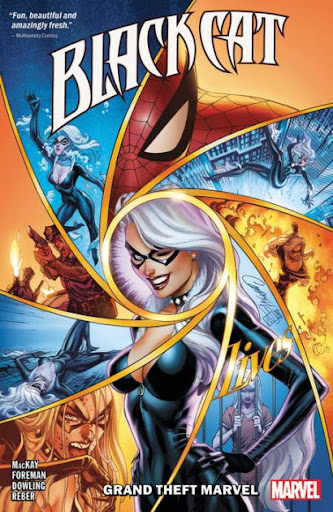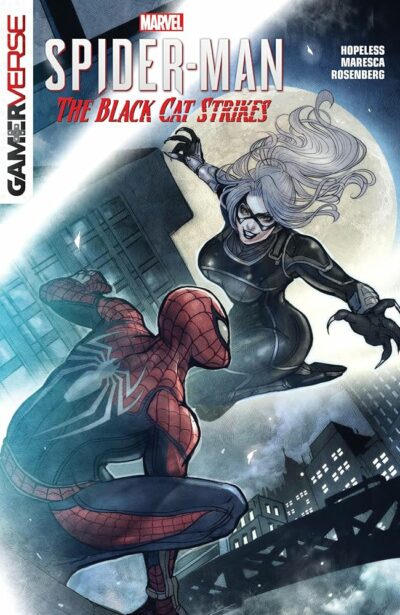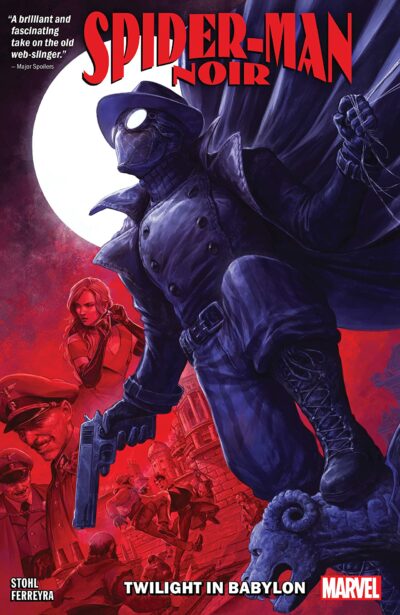With the movie rights to Spider-Man being one of Sony’s most valuable IPs at the moment, it’s not surprising that there have been a boatload of Spider-Man movies. Tobey Maguire had his trilogy, Andrew Garfield a duology, and Tom Holland seems set to be getting at least a quadrilogy.
Then we have the critically acclaimed Spider-Verse animated films, as well as Sony’s attempt at making their own cinematic universe with the likes of Venom, Madame Web, and the seminal classic Morbius.
And yet, even though Sony has mined the Spider-Man franchise for characters to make movies about for the past several years, we’ve never had a film with one of Peter Parker’s most integral enemies and allies: Felicia Hardy, the Black Cat.
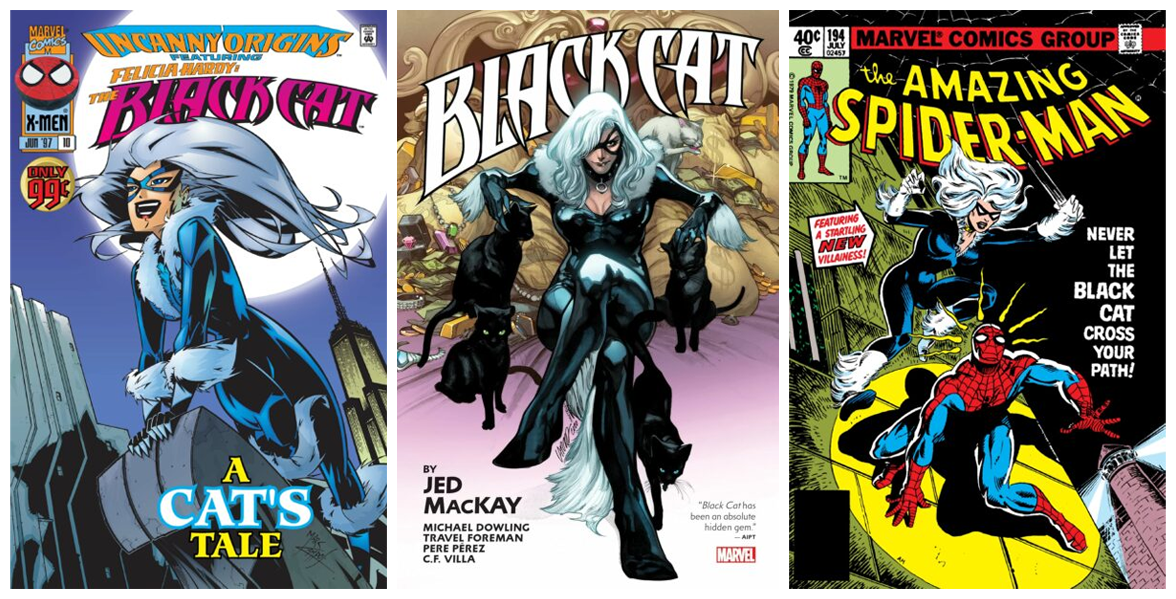
Uncanny Origins
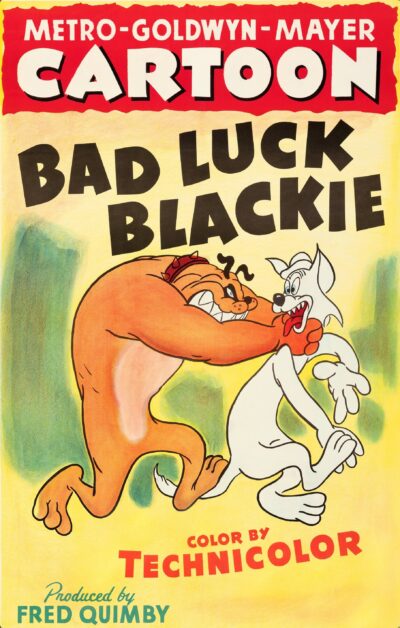
“Bad Luck Blackie” by Tex Avery
Black Cat was conceptualized by writer Marv Wolfman as a villain in Spider-Woman, but when Marvel Comics gave him the opportunity to work on The Amazing Spider-Man, Wolfman jumped at this chance, as most comic writers would, and brought his creation along for the ride. In 1979, the Black Cat debuted in The Amazing Spider-Man #194.
According to Wolfman the inspiration for Black Cat was the Tex Avery cartoon “Bad Luck Blackie,” in which a cigar-chomping black cat uses the gift of bad luck to punish an abusive bulldog.
However, as Spider-Man’s sometimes enemy, sometimes ally and love interest, the Black Cat developed a superficial resemblance to DC Comics’ Catwoman.
While Selina Kyle and Felicia Hardy are both cat-themed cat burglars who fraternize with the title hero of their respective books, Marvel writers have put in a lot of effort into differentiating the Black Cat from her predecessor.
The daughter of world-renowned thief Walter Hardy, Felicia Hardy discovered her father’s past and became enamored with the thrilling life of thievery. After a botched attempt at her own criminal career, Felicia was taken in by her father’s mentor, the Black Fox. Years later, she kicked off her new career as the Black Cat.
The Black Cat is highly skilled in all forms of thievery, from lock-picking to pick-pocketing, and her impeccable gymnastics skills allow her to go toe-to-toe with superhumans like Spider-Man. To push things even further in her favor, the Black Cat has cybernetic implants that, via technobabble buzzwords, give her a bad luck aura.
While Felicia Hardy briefly appears in The Amazing Spider-Man 2—played by Felicity Jones—the Black Cat persona has never appeared in films. And that’s a shame! Felicia is a great character who has sustained multiple comics both on her own and as a duo with other characters. She’s had some great cartoon and video game appearances as well!
At a glance, Black Cat may look like another dime-a-dozen femme fatale, but scratch below the surface and you find a woman torn between her desire for freedom and her loyalty to the people she loves. She’s a thief with a heart of… well, not gold. Silver? Bronze? Anyway, the Black Cat has a sense of fairness and justice that other members of Spider-Man’s rogues gallery lack. Being a thief is a profession, and as a profession, it comes with standards. It comes with rules and honor. And the Black Cat is a consummate professional.
The Rise of a Bicon
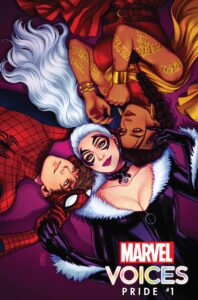 In recent years, Black Cat has become one of Marvel’s more prominent queer characters, with a greater focus on her dalliances with women. That isn’t to say that the idea of Felicia Hardy being gay or bi/pansexual is new, however. Much like fellow Marvel characters Mystique and Destiny, whose long-standing and heavily implied relationship was only recently canonized, Black Cat’s sexuality for much of her history has been a matter of implication, speculation and alternate universe interpretation.
In recent years, Black Cat has become one of Marvel’s more prominent queer characters, with a greater focus on her dalliances with women. That isn’t to say that the idea of Felicia Hardy being gay or bi/pansexual is new, however. Much like fellow Marvel characters Mystique and Destiny, whose long-standing and heavily implied relationship was only recently canonized, Black Cat’s sexuality for much of her history has been a matter of implication, speculation and alternate universe interpretation.
In Tom DeFalco’s Spider-Girl, a story set in a possible future Marvel Universe, Felicia is the divorced wife of Flash Thompson, with whom she has a daughter named Felicity. Felicity struggles to accept her mother’s new relationship with a woman named Diana—and this was all the way back in the 2000s!
In the 2020s, however, Marvel has fully embraced Felicia’s bisexuality. She featured alongside love interests Peter Parker and Odessa Drake on a variant cover by artist Jen Bartel for the 2022 issue of Marvel Voices: Pride, Marvel Comics’ annual Pride Month celebration. In the 2023 issue, Black Cat starred in a featured short story written by Sarah Gailey appropriately titled “Be Gay, Do Crimes.” The reaction to this story on social media was huge, cementing Black Cat’s status as one of Marvel’s most recognizable queer characters.
So let’s take a look at the woman, the legend, the bicon: The Black Cat!
Where to Start
Black Cat (2019-2021) by Jed MacKay
Although Black Cat has a 40+ year history, I recommend you start with her 2019 solo series by Jed MacKay.
This book gradually introduces a fleshed-out and slightly revised version of Black Cat’s origin story in between some daring heists across the Marvel Universe. Not even Dr. Strange’s Sanctum Sanctorum is safe!
Each story arc in this series sees the Black Cat teaming up with or butting heads against the heroes of the Marvel Universe. She tears up the town with Wolverine, fights an otherworldly invasion with Captain America and takes on a technocratic mafia with Spider-Man. This series has all the fun of a shared superhero universe without getting bogged down in the minutiae of continuity.
MacKay highlights Felicia Hardy’s most endearing characteristic: she’s a thief because it’s fun. Don’t get me wrong—she has some pretty serious motivations at times, and Spidey’s influence has definitely pulled her into the “great power, great responsibility” school of thought, despite her attempts to deny it. But at the end of the day, Felicia continues to don the costume and rob villains and heroes alike because there’s nothing else she’d rather do. In this way, the Black Cat is a highly self-actualized character who knows exactly who she is and what she’s about.
The Marvel Universe is full of tragic backstories and world-ending stakes, with vulnerable characters plagued by doubts and fears. In this context, a book about a sexy thief who is in it for the thrill of the game brings a levity that balances out the Marvel Comics lineup, while also being an entertaining story in its own right.
That isn’t to say this book is all fun and games. For example, the Thieves Guild of New York is seeking revenge for past grievances—and possibly for more selfish reasons on the part of the Guild’s leader, Odessa Drake. So there’s still plenty of drama to be had, but more often than not, this series had me smiling and even laughing in a few parts. Plus, it reminded me why I’ve loved the Black Cat ever since I saw her in the ’90s Spider-Man cartoon, and it gave me an unexpected nostalgia trip on top of all the other things I already loved about this comic.
What’s Next?
Jed MacKay’s Black Cat is an absolute blast, whether it’s the start of your Marvel Comics journey or if you just want to enjoy it as its own self-contained thing, and if you enjoy his take on the character, feel free to jump into his other works:
- Iron Cat: During the aforementioned Black Cat series, Felicia managed to steal a cat-themed Iron Man armor from Tony Stark. An old flame of Felecia’s now dons the armor, so the Black Cat and Iron Man must work together to stop her.
- Mary Jane & Black Cat: Black Cat and Mary Jane Watson are caught in the crossfire of the X-Men/Spider-Man crossover, Dark Web, and get stuck in Limbo. They try to work together while keeping their respective secrets under wraps.
Spider-Man vs. the Black Cat by Marv Wolfman
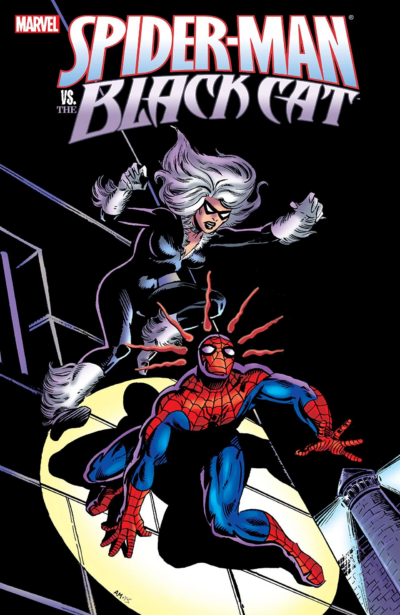 If you’re looking to start from Felicia’s true beginnings, this is it. This lovely little collection showcases the Black Cat’s first six appearances in The Amazing Spider-Man. The issues collected here are very representative of the Bronze Age of Comics, which stretched from 1970 to 1985.
If you’re looking to start from Felicia’s true beginnings, this is it. This lovely little collection showcases the Black Cat’s first six appearances in The Amazing Spider-Man. The issues collected here are very representative of the Bronze Age of Comics, which stretched from 1970 to 1985.
During this era, we saw prototypical examples of the anti-heroes who would later become popular in the ’90s, and I would certainly count Black Cat as one of them. Traditional heroes were still the main focus, but now they were dealing with darker storylines and heavy social issues such as drug use and, particularly relevant here, the failings of our punitive justice system.
In her first outing, Black Cat aims to free her father from prison so he can die at home, bringing into question whether or not Spidey is doing the right thing in trying to stop her. Walter Hardy may have been a thief, but is there any real justice in letting a non-violent criminal die in a cold jail cell?
The elements introduced in this book would go on to define the Black Cat to this day: her love and admiration for her father, her sense of justice that often conflicts with the heroes, and her complicated but meaningful relationship with Spider-Man Peter Parker. I read this collection after having seen multiple interpretations of the Black Cat—in comics, video games and cartoons—and she’s remained remarkably consistent across the decades thanks to this strong core characterization.
With evocative, moody art, morally complex stories and over-the-top emotional dialogue, this collection is a great showcase of the Bronze Age of Comics. It also presents a strong foundation for Black Cat’s character, making all the other amazing stories in this list possible. I really enjoyed this blast from the past, and I hope you will, too!
What’s Next?
After you get caught up on the Black Cat’s origins, check out some more Spider-Man books featuring the Black Cat and her complicated relationship with Spidey:
- Symbiote Spider-Man by Peter David: This 2019 book rewinds the clock to the Alien Costume Saga. During this time, the alien symbiote that would eventually spawn Venom was bonded to Peter, giving him the famous black suit. The Black Cat was Spidey’s primary love interest at the time, and this story sees villain Mysterio put that relationship to the test.
- The Amazing Spider-Man: Beyond by Zeb Wells: Spider-Man is out of commission and replaced by a corporate-sponsored doppelganger! The Beyond Corporation’s web-slinger shakes up the superhero business along with Peter Parker’s personal life–and Peter’s relationship with ex-girlfriend Felicia is no exception.
Into the Feline-Verse (Alternate Universe Stories)
Based on the 2018 game Spider-Man for the PlayStation 4, this book adapts the downloadable campaign “The Heist,” which centers on Spider-Man’s relationship with the Black Cat.
Expanding on Peter and Felicia’s relationship prior to the start of the game, as well as the events within the DLC campaign, The Black Cat Strikes is a solid rendition of Spider-Man and the Black Cat’s dynamic. In many ways, it’s an abridged version of their 40+ year history, with Cat genuinely giving the whole hero gig a shot but ultimately being unable and unwilling to deny her nature as a thief.
If you’re a fan of the video game interpretation of Spider-Man’s adventures but didn’t splurge for the DLC, or if you’re like me and you felt like Black Cat got a little shortchanged in her appearance, then I highly recommend checking this comic out.
Before Into the Spider-Verse introduced a family-friendly version of this character, the Spider-Man Noir comics lived up to their name.
And yes, it does feel weird to call a character voiced by Nicholas Cage “family friendly.”
Anyway, Spider-Man Noir takes place in the middle of the Great Depression with a hardened version of Peter Parker who nonetheless fights against the rising tide of fascism both at home and abroad.
In this setting Felicia Hardy is Peter’s main love interest, as opposed to the more prominent Mary Jane Watson of the main universe. Felicia runs the Black Cat Club and has a nasty habit of getting romantically involved with mob bosses. She and Peter are deeply in love, but their relationship is even more of a mess than it is in the mainstream continuity.
I won’t go into much more detail than that. Part of the appeal of a noir is seeing the twists and turns and the tension of knowing that pretty dames like Felicia don’t often make it out alive in these sorts of stories. You’ll have to read the comic to see if she’s one of the lucky ones or if the Black Cat’s luck finally runs out.
This is indeed a classic noir played straight, even though Spider-Man can still do whatever a spider can. Spider-Man Noir can be an emotionally challenging read at times as a result, but fans of the genre are likely already prepared for that.
This book is a cool premise executed almost perfectly, so give it a shot if the title entices you. Check out the sequels as well, with David Hine returning for Eyes Without a Face and Margaret Stohl finishing off the trilogy with Twilight in Babylon.
Final Thoughts
This has been the most difficult post to edit for length that I’ve ever worked on. I really wanted to get into the cartoon side of things since Spider-Man: The Animated Series has a unique and deeply compelling take on Felicia Hardy, while The Spectacular Spider-Man is more faithful to the comics but no less… well, spectacular! And there are tons of other cool comics featuring the Black Cat as an antagonist and supporting player, like Silk: Out of the Spider-Verse, Venom Inc. or Spider-Man: Miles Morales. Even limiting ourselves to Pinnacle’s collection, there are so many amazing stories to talk about!
Unfortunately, comics and cartoons don’t draw the same attention as film, so I don’t think the Black Cat has gotten the full appreciation she deserves just yet. Until the Black Cat has her moment to shine on the silver screen, I hope I’ve convinced you that she is a comic book character worthy of your time!

